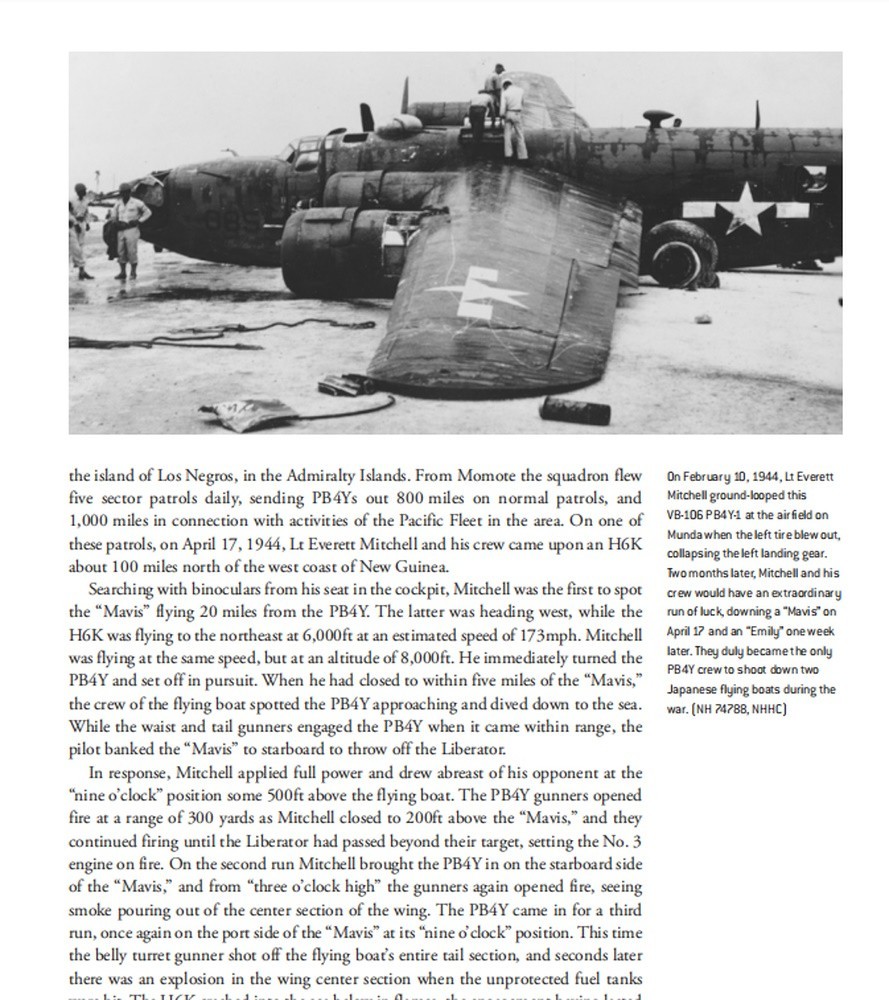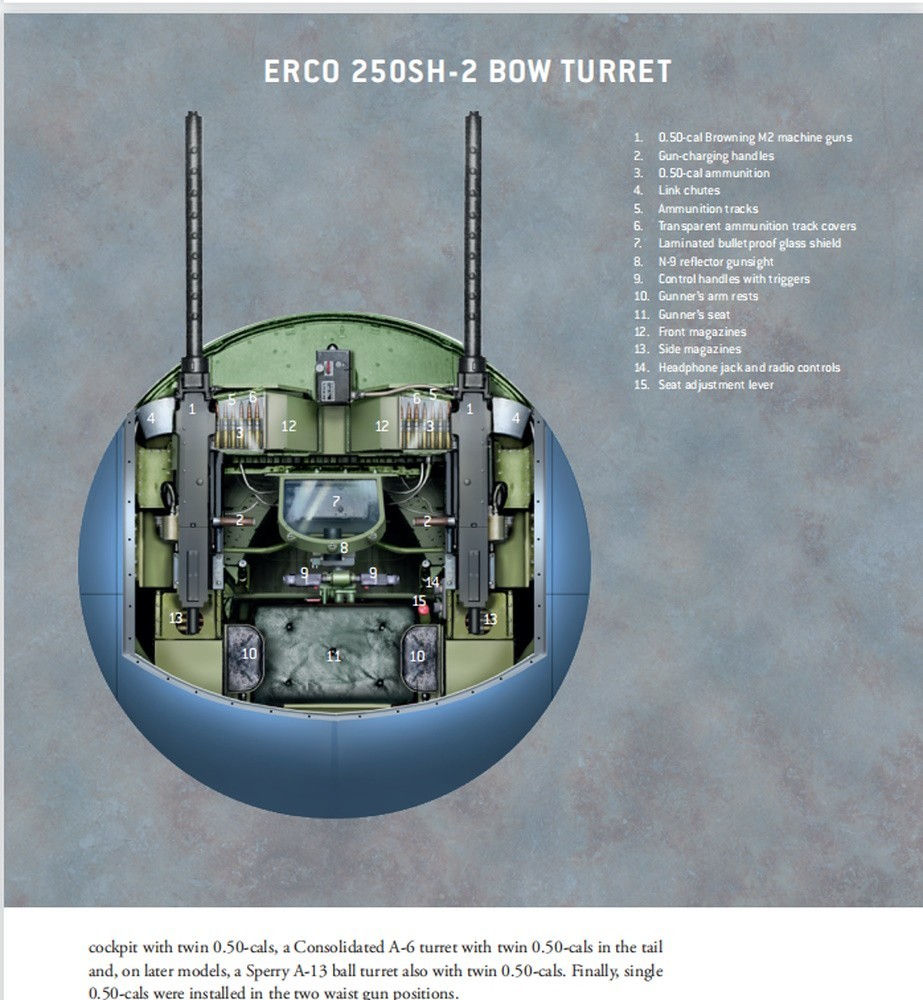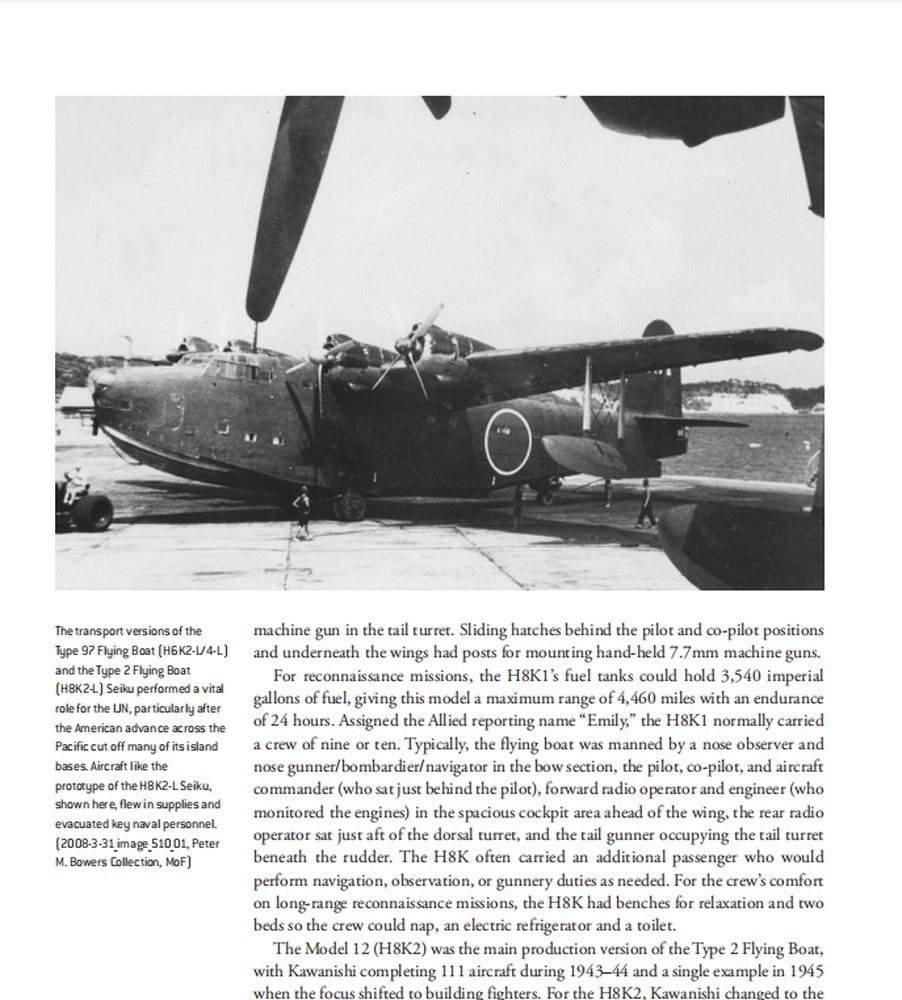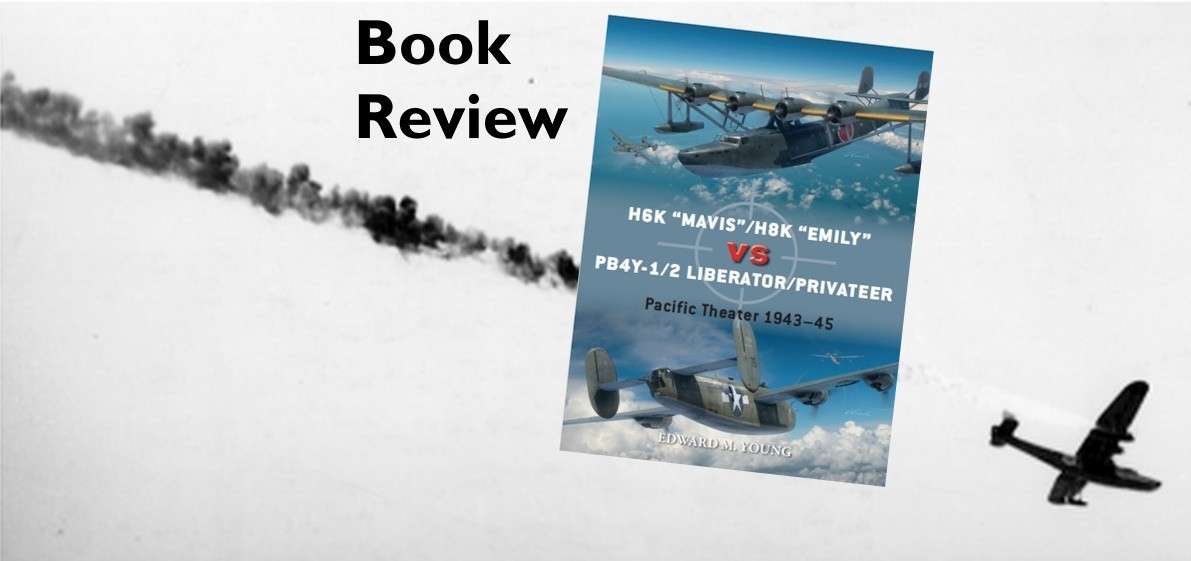
Introduction
H6K “Mavis”/H8K “Emily” vs PB4Y-1/-2 Liberator/Privateer Pacific Theater 1943-45 is a new book from Osprey Publishing. This book examines the unusual aerial combat between four-engine patrol aircraft across the vast expanses of the Pacific. Authored by Edward M. Young and illustrated by Jim Laurier and Gareth Hector, this 80-page book is a softback and cataloged with ISBN 9781472852502 and with the Osprey short code DUE 126.
"Mavis" and "Emily" have a special compartment in my aerial and modeling brain. Since my quinquagenarian reading of The Log of the Liberators where I learned of these encounters, I have wondered how often these behemoths dueled each other over the Pacific. A few years ago a magazine wrote of USAAF B-17 battles against H6Ks and it renewed my interest in the subject. Honestly, I never dreamed that someone would research and write about this chapter of the Pacific air war.
Historical
Japan relied heavily on long-range flying boats and although the United States Navy did too, land-based bombers became more of an option for USN. Thus the stage was set for eventual encounters between American four-engine bombers and the four-engine Japanese flying boats. The PB4Y Liberator was a modified heavy strategic bomber (the PB4Y-2 Privateer was a development of the PB4Y-1) and bristled with .50-caliber heavy machine guns and powered turrets. The Japanese fielded the long-range but weakly defended Kawanishi H6K Type 97 Flying Boat (Kyu-nana Shiki Hikoh-tei), code named “Mavis” and the outstanding flying boat of the war, the Kawanishi H8K Type 2 Flying Boat (Ni Shiki Hikoh-tei), code named "Emily." Emily was fast, very long range, and also heavily armed with 20 mm cannons.
Emilys actually pulled off a second attack on Pearl Harbor in early 1942; staging off of a lonely isolated atoll and serviced by a submarine, a pair penetrated American defenses and overflew Pearl Harbor and environments, dropped bombs, and majestically sailed off unscathed. I was amazed at the circumstances of the first Emily combat loss - to a most unlikely aircraft.
Indeed, Mavis and Emily ranged far and wide over the Pacific and Mavises dueled PBYs and B-17s early in the war. Sometimes the Mavis hit the Flying Fort back hard but in many cases the Mavis, lacking armor or self-sealing protected fuel tanks, wound up as blazing torch crashing into the ocean. There are many photographs of them meeting their doom. Emily was different, with well-protected fuel tanks and with four 20 mm cannon, Emily had the potential to defend herself. Against them the PB4Ys were festooned with .50-caliber heavy machine-guns, fast firing with lots of ammunition, and flown by aggressive crews so there are many photographs of Emilys meeting their doom.
Not only will this book reveal a unique story of the Pacific War air war, it provides good reference material for modelers.
Content
H6K “Mavis”/H8K “Emily” vs PB4Y-1/-2 Liberator/Privateer is told through 11 chapters and supporting sections in 80 pages:
Introduction
Chronology
Design and Development
Technical Specifications
The Strategic Situation
The Combatants
Combat
Statistics and Analysis
Aftermath
Further Reading
Index
Introduction and Chronology introduces us to the imperative that a key for military success is the ability to scout out what the enemy is doing while denying your information to the enemy. It is especially important in the vastness of the Pacific. The United States Navy and in fact any combatant that would find itself over the oceans used seaplanes and flying boats for scouting and patrol. Probably none were more important than over the thousands of miles of open ocean of the Pacific. There, as aircraft technology progressed beyond one, two or three-engine biplanes, or converted airliners like Nazi Germany’s Focke-Wulf FW-200 Kondor, the United States Navy and the Imperial Japanese Navy perfected large and sophisticated long-range aircraft. For the Japanese, flying boats were their go-to although long-range Japanese bombers such as the G3M (Allied codename “Nell”) and G4M “Betty” bombers also operated from land bases in the role. Interwar, after an atmospheric turf battle between the United States Navy and the United States Army, the Navy was regulated to, naturally, flying boats. But with the advent of the B-17 and B-24 heavy bombers, it soon became apparent that those aircraft would give the Navy, and by extension the Army which the Navy often supported, a far superior capability. USAAF grudgingly realized that and sparingly provided the Navy with B-24s.
Chapters Design and Development and Technical Specifications deliver background of the aircraft. The PB4Y-1 was the Consolidated B-24 Liberator and PB4Y-2 was developed from the PB4Y-1 . The Privateeer is very easy to identify as it was a stretched version with a single tall tail. On the Japanese side, The H6K is one of those airplanes...well, beauty is in the eye of the beholder. Some people find the parasol-wing flying boat design very graceful while others think she looks like a llama - described as a horse assembled by committee. The Mavis fuselage bent upwards in the rear like a banana with the rear turret almost as high as the mainplane. The Emily was a completely different design bearing resemblance to flying boats like Great Britain's Sunderland and Empire flying boats, and Boeing Clippers. Emily looked like a flying boat, with a slab sided high fuselage and high mounted wings. It had a very business-like and stern look to it. And yet it was fast and had incredible range, able to stay a lot for over 24 hours.
The Strategic Situation recounts the battlefield across the vast Pacific, methods and areas of aircraft basing, and operational policies and doctrines. The Combatants details the recruitment, training (pilots, gunners, navigators, et. al), roles and equipping of aircrews. It discusses the expansion of the US military.
The 20-page chapter Combat is the meat of this book. It describes the roughly year and a half that these aircraft encountered each other, resulting in a lopsided kill to loss ratio. Of particular interest are accounts of patrol planes out minding their business of patrolling and reconnaissance, seeking opportunities for offensive action such as attacking airfields and sinking ships, only too encounter their kindred adversary. One of these missions resulted in the interception of a flying boat ferrying a high ranking admiral, recounting the subsequent fight and outcome.
Offensive and defensive tactics are presented. The pages hold several detailed narratives such as;
During the action the PB4Y had received negligible damage from the “Emily’s” return fire, the aircraft having suffered just two machine gun hits near the port and starboard waist hatches. While the return fire was ineffective, Thompson stated in the Aircraft Action Report that he was impressed with the evasive maneuvers employed by his opponent. Violent turns had been accomplished with “evident ease,” although ultimately to no avail. The report also noted that “it is believed that this is the first reported instance of a plane being picked up by RCM gear and identified positively as enemy on the basis of a difference in frequency.” It also appears to have been the first, and possibly only, time during the war that a US Navy aircraft used RCM instrumentation in combination with airborne search radar to locate an enemy aircraft.
...and...
When the PB4Y was 500 yards away from the “Emily,” the bow gunner opened fire, concentrating on the No. 3 engine and then switching to the No. 2 engine. With the latter soon on fire, the pilot of the “Emily” banked the aircraft to port, with the PB4Y following, continuing the attack from the “five o’clock” position and above. As Box steepened his dive, the top turret gunner and the port waist gunner opened fire on the “Emily” at a range of 300 yards, setting the flying boat’s No. 3 engine on fire.
Statistics and Analysis and Aftermath wrap up the successes and failures of the aircraft, compares weight of fire between Emily cannon and USN .50-calibers, and examines the kill-to-loss ratios. Attrition and capture of IJN flying boats is discussed, as well as USN stateside testing of an Emily and its eventual fate. An incredible revelation is of the designer of the H8K and his work with the Japan Maritime Self‑Defense Force.
Overall, this has been an amazingly enjoyable subject.
Photographs, artwork, graphics
This book has a appreciable gallery of photographs from Japanese and Allied sources. There are several images of flying boats going down and flames, including some sequences of a flying boat's demise. There are also several photos that aside from source material for building a better model, may inspire modelers to create dioramas. Some amazing photographs include;
- A scene from IJN seaplane tender Akitsushima II as it suspends a H8K from a crane alongside the ship.
- Atop the wing view of a H6K undergoing engine maintenance in the South Pacific.
- An H8K on beaching gear next to an A6M2‑N "Rufe" floatplane fighter.
Original artwork from Jim Laurier and Gareth Hector presents us with what the camera failed to capture, in full color. These include profiles and planned forms, cutaways showing particular components and compartments of aircraft, and recreations dramatic recreations of combat.
H6K5 Model 23 “MAVIS” Type 97 Flying Boat, “U3‑30,” assigned to the 801st Kokutai, Hokkaido, November 1943, in profile.
H8K2 “EMILY”, 51‑085,” 851st Kokutai, Central Pacific: in planform; profile; head-on.
PB4Y‑1 LIBERATOR, BuNo 38889 (USAAF serial number 44‑41246), VPB‑104, Tacloban, December 1944: in planform; profile; head-on.
H8K "Emily" Tail Turret: gunner-view keyed to nine components.
ERCO 250SH‑2 Bow Turret: planform cutaway keyed to 15 components.
PB4Y‑1 Liberator Cockpit: pilot's-eye view keyed to 66 items.
H8K "Emily" Cockpit: pilot's-eye view keyed to 41 items.
Map: Extent of Japanese Conquest and American Advances.
Engaging the Enemy: gunner's view through an ERCO turret while gunning down an "Emily."
Combat Scene: Two-page spread of a PB4Y attacking an "Emily."
Tables
Comparison Specifications featuring 11 technical and operational characteristics for the:
- H6K4 Type 97 Model 22
- H8K2 Type 2 Model 12
- PB4Y‑1 Liberator
- PB4Y2 Privateer
PB4Y claims against the “Mavis” and “Emily” in 1943–45: number of each type destroyed by one of nine squadrons.
All artwork is very well rendered.




Conclusion
Yes, I am very enthusiastic about Osprey's new Duel title H6K “Mavis”/H8K “Emily” vs PB4Y-1/-2 Liberator/Privateer Pacific Theater 1943-45. It features detailed and insightful text, quick writing that carried me along whole describing and explaining a topic, and an amazing story. The visual component supports the text I think provides modelers with a fin amount of source material.
Students and fans of the Pacific air war in general, and these four-engined fighting aircraft in particular, will find this a worthwhile addition to their book shelf, I am certain. Recommended.
Please remember to mention to Osprey and retailers that you saw this product here - on Aeroscale.




























